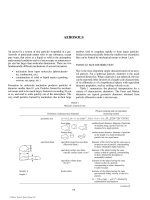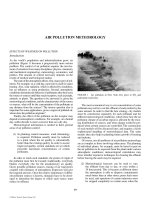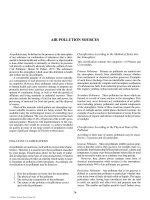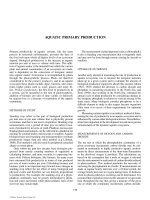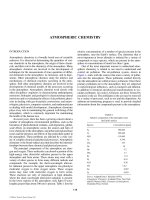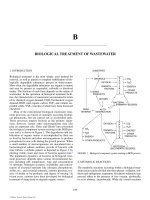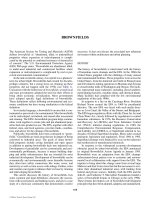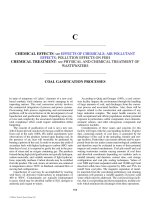ENCYCLOPEDIA OF ENVIRONMENTAL SCIENCE AND ENGINEERING - WATER AND WASTE MANAGEMENT SYSTEMS IN SPACE ppt
Bạn đang xem bản rút gọn của tài liệu. Xem và tải ngay bản đầy đủ của tài liệu tại đây (406.02 KB, 14 trang )
1242
W
WATER AND WASTE MANAGEMENT SYSTEMS IN SPACE
INTRODUCTION
Environmental Control and Life Support System (ECLSS) is
the NASA terminology for the systems which allow people
to exist and work in confined spaces and in uninhabited loca-
tions and hostile environments. These systems supply air,
water, temperature and humidity controls to enable personnel
to survive and work under hostile conditions. The purpose
of this paper is to review the various devices that have been
developed for the recovery and reuse of liquid wastes in
spacecraft and space stations, and their possible terrestrial
applications.
A SHORT HISTORY OF U.S. SPACECRAFT
ECLS SYSTEMS
The U.S. spacecraft ECLS systems have grown in capa-
bilities and complexity as the spacecraft have grown and
the duration of their missions has been extended. Initial
systems were almost completely open loop, with only CO
2
removal in a closed loop. There was no recycling of water
or wastes. On the Orbiter, water is not recycled, but is
vented overboard. Air is recycled. Solid wastes are returned
to the earth. This system will be changed as the Orbiter
is reconfigured for longer duration missions. Due to the
high cost of transporting fresh water and oxygen into orbit,
the space station is designed to operate in an almost com-
pletely closed loop mode. Only solid body waste and trash
will be returned to the earth. Air and liquid wastes will be
recycled.
Regenerative systems have been evaluated by NASA for
the different functions of the ECLSS (Figure 1).
1
A partial list
of the various technologies is given in Table 1. The emphasis
is on purification and recycling the air and wastewater streams
for atmosphere revitalization and water recovery and manage-
ment. The high cost of transporting mass into orbit, approxi-
mately $22,000/kg, causes NASA to place a premium on low
weight, low volume, high efficiency, and low maintenance
requirements.
2
DRINKING WATER QUALITY STANDARDS
NASA has very strict standards for water consumed on the
shuttle, and even stricter standards for the proposed space
station. This is logical, as the water on the space station will
be continuously recycled, and hence the astronauts will be
exposed to this water for an extended duration. Table 2 lists
the present potable water standards for the shuttle and Space
Station Freedom (SSF), and compares these to the existing
EPA potable water standards. The SSF hygiene water stan-
dards are also shown in the table. These standards were
established early in the program.
3
In order that hardware designers should have constant
reference solutions to use when testing their equipment,
NASA found it necessary to determine the compositions of
urine and wastewater that would be produced on the space
station. Hence NASA analyzed average urine composi-
tion, and determined a chemical model for urine, which
could be made up and used to test recycling equipment.
Similarly, a chemical model formula for hygiene water,
i.e., water used for personal washing, laundry, and food
preparation, was derived. These model compositions for
urine and wastewater were then used to test individual items
of hardware and complete processing systems. However,
the final evaluation tests must include the processing of
urine and wastewater obtained from volunteers living in a
closed test environment.
TECHNOLOGIES TESTED FOR USE IN THE ECLSS
Various technologies were tested and/or evaluated for the
ECLSS systems, with the emphasis on the water and air revi-
talization systems. Less attention has been paid to the treat-
ment of solid waste, as this will only be required for long
space voyages and for long term inhabitation of stations on
the moon and planets. A number of water recovery and waste
management systems have been tested for application in the
space station. These systems have been evaluated by com-
paring them to the baseline technology that was originally
C023_001_r03.indd 1242C023_001_r03.indd 1242 11/18/2005 1:29:10 PM11/18/2005 1:29:10 PM
© 2006 by Taylor & Francis Group, LLC
WATER AND WASTE MANAGEMENT SYSTEMS IN SPACE 1243
ECLSS
Temperature
and Humidity
Control (THC)
Atmosphere
Control and
Supply (ACS)
Atmosphere
Revitalization
(AR)
Fire Detection
and
Suppression
(FDS)
Water
Recovery and
Management
(WRM)
Waste
Management
(WM)
Air
Temperature
Control
Humidity
Control
Air
Particulate
Control
Ventilation
Intermodule
Ventilation
Avionics Air
Cooling
Refrigerator/
Freezers
EVA
Support
Urine
Processing
Combined
Potable/Hygiene
Processing
Online Water
Quality
Monitoring
EVA Support
Fuel Cell Water
Transfer/Storage
Contamination
Recovery
Experiment
Support
Waste
Storage &
Return
Fecal
Waste
Processing
Urine
Collection and
Pretreatment
Vent & Relief
O
2
/N
2
Pressure
Control
O
2
/N
2
Storage
O
2
/N
2
Distribution
Experiment
Support
Contingency
Gas
Support
CO
2
Removal
CO
2
Venting
Tra c e
Contaminant
Control
Major
Constituent
Monitoring
Trace
Contaminant
Monitoring
Fire Detection
Fire
Suppression
Water
Distribution
Water Venting
O
2
Generation
CO
2
Reduction
(SCAR)
FIGURE 1 Space Station Alpha Environmental Control and Life Support System (ECLSS) Functions.
Source: Ref. 4.
C023_001_r03.indd 1243C023_001_r03.indd 1243 11/18/2005 1:29:11 PM11/18/2005 1:29:11 PM
© 2006 by Taylor & Francis Group, LLC
1244 WATER AND WASTE MANAGEMENT SYSTEMS IN SPACE
selected for the space station. The original baseline system
was the Thermoelectric Integrated Membrane Evaporation
Subsystem (TIMES). This was replaced by a new baseline
subsystem which is a combination of multibed filtration
(Unibed) and Vapor Compression Distillation (VCD). These
baseline systems along with many other promising technolo-
gies are described below.
In all cases urine is pretreated immediately upon collec-
tion to minimize bacterial growth and possible damage to
collection and handling equipment. In addition to inhibiting
bacteria, the treatment is intended to control ammonia, sta-
bilize dissolved solids to prevent precipitation, and allow the
overall subsystem to function in a zero-gravity environment.
Present pretreatment comprises the injection of either Oxone
TABLE 1
ECLSS Technologies Used or Evaluated
ECLSS Subsystem Category Used/Evaluated Technology
Atmosphere revitalisation Used LiOH
Used Molecular sieve
Used Sabatier reactor
Used Static feed water electrolysis
Evaluated Solid amine fixed bed
Evaluated Liquid sorbent closed loop
Evaluated Bosch system
Evaluated Algal bioreactor
Evaluated Growing green plants
Trace Contaminant Removal Used Activated charcoal
Used Catalytic oxidiser
Used Particulate filters
Water recovery and management Used
*
Vapor compression distillation
Used Chlorine
Used Sodium hypochlorite injection
Used Iodine injection
Used Heat sterilisation
Used Fuel cell by-product water
Evaluated
*
Unibed filter
Evaluated
*
TIMES membrane filter
Evaluated
*
Reverse osmosis
Evaluated
*
Electrodialysis
Evaluated
*
Electrooxidation
Evaluation
*
Supercritical water oxidation
Evaluation
*
Electrodeionisation
Evaluation
*
Air evaporation
Evaluation
*
Vapor phase catalytic ammonia removal
Evaluation
*
Immobilized cell or enzyme bioreactors
Evaluation
*
Plant transpiration and water recovery
Temperature and humidity control Used Condensing heat exchangers
Used Water cooled suits
Atmosphere control and supply Used Compressed gas storage
Used Cryogenic gas storage
Waste management Used Urine stored in bags
Used Feces stored in bags
Used Urine vented
Used Feces stored in bags and vacuum dried
Used Urine stored in tank and vented
Used Feces stored in bags and compacted
*
Described in this paper.
C023_001_r03.indd 1244C023_001_r03.indd 1244 11/18/2005 1:29:11 PM11/18/2005 1:29:11 PM
© 2006 by Taylor & Francis Group, LLC
WATER AND WASTE MANAGEMENT SYSTEMS IN SPACE 1245
TABLE 2
Water Quality Standards Comparison
QUALITY PARAMETERS Shuttle Potable EPA Current SSF Potable SSF Hygiene
PHYSICAL PARAMETERS ————
TOTAL SOLIDS (mg/L) 5 to 10 500 100 500
“COLOR, TRUE (Pt/Co units)” 15 15 15 15
CONDUCTIVITY Reference only — — —
TASTE (TTN) 3 — 3 N/A
ODOR (TON) 3 3 3 3
PARTICULATES
(max size—microns)
— — 40 40
pH Reference only 6.5–8.5 6.0–8.5 5.0–8.5
TURBIDITY (NTU) 11 1 1 1
DISSOLVED GAS (free @ 37°C) None at 1 AT — (see Note 1) N/A
FREE GAS (@ STP) — — (see Note 1) Note 1
INORGANIC CONSTITUENTS
(mg/L)(see Notes 2 and 5)
————
ALUMINUM — 0.05 — —
AMMONIA — — 0.5 05
ARSENIC — 0.05 0.01 0.01
BARIUM — 2 1 1
CADMIUM 0.01 0.01 0.005 0.005
CALCIUM — — 30 30
CHLORINE
(Total—Includes chloride)
— 250 200 200
CHROMIUM 0.05 0.1 0.05 0.05
COPPER 1.00 1 1.00 1.00
IODINE
(Total—Includes organic iodine)
Reference only — 15 15
IRON 0.3 0.3 0.3 0.3
LEAD 0.05 0.05 0.05 0.05
MAGNESIUM — — 50 50
MANGANESE 0.05 0.05 0.05 0.05
MERCURY 0.005 0.002 0.002 0.002
NICKEL 0.05 0.1 0.05 0.05
NITRATE (NO
3
-N) — 10 10 10
POTASSIUM 1 — 340 340
SELENIUM 0.01 0.05 0.01 0.01
SILVER 0.1 0.1 0.05 0.05
SULFATE — 250 250 250
SULFIDE — — 0.05 0.05
ZINC 5 5 5 5
BACTERICIDE (mg/L) ————
RESIDUAL IODINE
(minimum)
Reference only — 0.5 0.5
RESIDUAL IODINE
(maximum)
Reference only — 4 6
AESTHETICS (mg/L) ————
CATIONS — — 30 N/A
ANIONS — — 30 N/A
CO
2
(see Note 1) — — 15 N/A
(continued)
C023_001_r03.indd 1245C023_001_r03.indd 1245 11/18/2005 1:29:11 PM11/18/2005 1:29:11 PM
© 2006 by Taylor & Francis Group, LLC
1246 WATER AND WASTE MANAGEMENT SYSTEMS IN SPACE
(a potassium monopersulfate compound) combined with sul-
furic acid, or hypochlorite (bleach) before distillation.
Thermoelectric Integrated Membrane
Subsystem (TIMES)
This was the original baseline water recovery subsystem for
the space station (Figure 2). Wastewater is heated to 66ЊC
in a heat exchanger, and is then pumped through bundles of
small diameter hollow Nafion fiber membranes in the evap-
orator module. The Nafion allows only water, gases, and
small neutral molecules to pass through. The pressure on the
exterior of the membrane is reduced to 17 kPa (2.5 psi) to
assist in both transport through the membrane, and subse-
quent evaporation. The water vapor is then condensed, and
the latent heat of condensation is conducted to the input heat
exchanger. The TIMES system was found to produce poorer
quality water than the VCD.
4,5
Vapor Compression Distillation (VCD)
The VCD process involves spreading a thin film of the waste-
water on the inside wall of a thin-walled rotating drum under
low pressure, typically about 4.8 kPa (0.7 psi). The VCD is
shown in Figure 3, and in-depth discussions may be found
in Refs. 4, and 6–11. The system operates at 35ЊC which is
slightly above ambient temperature. Heat is applied to the
outside of the wall causing the thin film of water to boil. The
vapor is extracted from the drum interior and compressed
by a pump. The compressed vapor is then condensed on the
exterior wall of the drum. The compressed vapor condenses
at a higher temperature than that at which it had originally
evaporated. The latent heat of condensation thus supplied
the heat required to evaporate the original feed water in the
inside of the drum. The unevaporated brine, heavily loaded
with contaminants, is recycled back to the inflow stream, or
passed to another subsystem.
TABLE 2 (continued)
QUALITY PARAMETERS Shuttle Potable EPA Current SSF Potable SSF Hygiene
MICROBIAL None Viable — — —
BACTERIA (CFU/100 mL) ————
TOTAL COUNT — — 1 1
ANAEROBES — — 1 1
COLIFORM — 1 1 1
ENTERIC — — — —
VIRUS (PFU/100 mL) — — 1 1
YEAST and MOLD
(CFU/100 mL)
——11
RADIOACTIVE CONSTITUENTS
(pCi/L)
NRC LIMITS (see Note3) ——
ORGANIC PARAMETERS (mg/L) (See
Note 2)
————
TOTAL ACIDS — — 500 500
CYANIDE
(total including organic cyanides)
— — 200 200
HALOGENATED HYDROCARBONS — 0.1 (THM)
*
10 10
TOTAL PHENOLS — — 1 1
TOTAL ALCOHOLS — — 500 500
TOTAL ORGANIC CARBON (TOC) Reference only — 500 10000
UNCHARACTERIZED TOC (UTOC) — — — —
(see Note 4) — — 100 1000
ORGANIC CONSTITUENTS (mg/L) — — — —
(see Notes 2 and 5) — — — —
Note 1: No detectable gas using a volumetric gas vs. fluid measurement system. This excludes CO
2
used for aesthetics
purposes.
Note 2: MCLs considered independently of others.
Note 3: The maximum contaminant levels for radioactive constituents in potable and personal hygiene water shall
conform to Nuclear Regulatory Commission (NRC) regulations (10CFR20, et al.). These maximum contaminant levels
are listed in the “Federal Register Vol 51, No: 6, 1986, Appendix B, Table 2.
Note 4: Total organic carbon minus identifiable organic contaminants.
Note 5: MCLs for others, if found, will be established as necessary.
*
THM = Trihalomethanes
SSF = Space Station Freedom
Source: Ref 3.
C023_001_r03.indd 1246C023_001_r03.indd 1246 11/18/2005 1:29:11 PM11/18/2005 1:29:11 PM
© 2006 by Taylor & Francis Group, LLC
WATER AND WASTE MANAGEMENT SYSTEMS IN SPACE 1247
Thermoelectric
Regenerator
Waste
water
Purified
Water
Membrane
Evaporator
Wastewater
Heat Exchanger
Thermoelectric
Elements
Condenser
Latent
Heat
Hollow Fiber
Membranes
Water Vapor
Waste
water
FIGURE 2 Schematic diagram of the TIMES (Thermoelectric Integrated Membrane Subsystem). Source: Ref. 4.
Reverse Osmosis (RO)
Reverse osmosis is a process in which pressure is applied
to a concentrated solution which is on one side of a semi-
permeable membrane. The pressure forces the molecules of
solvent through the membrane to the pure solvent or more
dilute solution on the other side. Greater concentration dif-
ferential between the two solutions on either side of the
membrane require greater pressure. A test unit containing
a bundle of tubes, capable of operating at up to 4140 kPa
(600 psi), was evaluated. When wash water containing soap
was processed a soap gel film formed on the membrane sur-
faces.
12
Reverse osmosis is a candidate for producing high
quality water. A combination of several systems, including
RO, produced water that met National Committee for Clinic
Laboratory Standards.
13,14
Multifiltration (Unibed)
The multifiltration system comprises a heat sterilization unit
to kill microorganisms, followed by a series of progressively
finer particulate filters down to 0.5 microns to avoid par-
ticulates clogging the sorbent beds.
15
The water then enters
the Unibeds which remove the dissolved contaminants. The
Unibed is a single replaceable unit which utilizes a set of beds
of different sorptive materials arranged in a specified opti-
mum sequence (Figure 4). The beds are designed to remove
specified types and amounts of contaminants from a known
waste stream in such a way that all the beds are exhausted at
the same time. A sequence of Unibeds of identical design,
each comprising three five-tube replaceable subunits, may be
used. Unidentified compounds are generally removed by a
mixture of several types of activated charcoal and nonionic
sorbents near the outlet from the bed. Microbial control to
avoid bacterial fouling of the various beds is achieved by
iodinated resin beds at the inlet and outlet of each Unibed.
Detailed discussions of the system may be found in Refs. 11,
and 14–16.
Electrooxidation—Combined Electrolysis and
Electrodialysis
Electrodialysis alone removes ions more efficiently than does
reverse osmosis (RO); however, when combined with elec-
trolysis the organic compounds are oxidized in the electroly-
sis and the inorganic salts are removed by the electrodialysis.
7
A combined electrolytic and electrodialytic cell is illustrated
in Figure 5. No chemicals are used. Low voltages are used to
avoid unwanted side effects such as the production of chlorine,
or the formation of insoluble salts. Various types of electrode
materials have been tested. Efficiency was increased consider-
ably when the polarity across the electrodes was periodically
reversed. This procedure is termed Periodic Reverse Pulsed
Electrolysis (PRPE). The process has theoretical advantages
over RO, as increasing the brine concentration improves
the conductivity, and hence the efficiency of the process.
Electrooxidation effectively kills bacteria in the feed.
17
Supercritical Water Oxidation (SCWO)
Wastewater is heated to a temperature of 650ЊC under pressures
of 250 atmospheres. When water is above its critical point, its
properties as a solvent change. Organic compounds which are
insoluble at normal temperature and pressure become soluble.
The addition of sufficient oxygen then leads to the complete
oxidation of these compounds. Most atmospheric gases and
trace contaminant gases are also soluble in supercritical water,
and will also be oxidized. The process also has the potential
C023_001_r03.indd 1247C023_001_r03.indd 1247 11/18/2005 1:29:11 PM11/18/2005 1:29:11 PM
© 2006 by Taylor & Francis Group, LLC
1248 WATER AND WASTE MANAGEMENT SYSTEMS IN SPACE
for oxidizing much of the organic solid wastes produced on
the space station.
18
Inorganic salts are produced when human
metabolic wastes are subjected to supercritical water oxida-
tion. These salts have very low solubility in supercritical water
and precipitate out, and thus can be removed.
19
Metals are also
precipitated out, with the exception of mercury, which car-
ries over in the vapor phase, and has to be removed by ion
adsorption.
20
Electrodeionisation
Feed water moves through an ion exchange resin bed
which selectively removes certain ions from the water.
Simultaneously, the resin is regenerated by the action of
an electric field imposed upon the resin bed.
21
A schematic
process diagram may be found in Ref 21. Bacteria are not
completely removed. It appears that this process works best
to remove ionic contaminants. It is a candidate for the pro-
duction of reagent grade water. Both benchtop and industrial
capacity units are available.
Air Evaporation
A system with a heat pump and solar collectors for evapora-
tive heat was tested. The system is capable of 100% water
recovery from numerous types of contaminated sources. The
wastewater is pretreated with a chemical solution to pre-
vent decomposition and bacterial growth. It is then pumped
through a wick filter to remove particles, in a series of pulses.
The timing of the pulses is such that the liquid from one pulse
is distributed along the wick by capillary action before the
next pulse arrives. A heated air stream evaporates the water
from the wick, leaving the solids behind. When the wick is
full of solids, it is dried and replaced by a new wick. The air
and vapor stream passes through a condensing heat exchanger
and then through a water separator to extract the free water
from the stream and test it for quality. It is then transferred to
the post-treatment filter section and thence to the main water
storage and distribution system. The wick system can be ster-
ilized by heating it to 121ЊC while in a dry state.
22
Vapor Phase Catalytic Ammonia Removal (VPCAR)
Neither pre-treatment nor post-treatment of the feed and
product water are required. The high temperature employed
also destroys microbes to a very great extent.
23
The present
design utilizes the thin film evaporation technique of the
VCD process in a rotating disk evaporator, combined with
catalytic reactors for vapor phase chemical reactions. The
ammonia and volatile hydrocarbons which are evaporated
along with the water vapor are oxidized to innocuous gases
by catalytic chemical reactions carried out in the vapor phase.
The overall system schematic is shown in Figure 6.
10,11
The
vapor from the VCD boiler passes over two catalytic beds.
The first bed operates at a temperature of about 250ЊC, to
oxidize organic volatiles to CO
2
and water, and ammonia to
NO and water. The second bed operates at 450ЊC and reduces
the NO to N
2
and O
2
. The O
2
produced is more than sufficient
for first bed usage. The vapor is recycled to maximize O
2
utilization. This high temperature vapor or steam supplies the
Outer Shell
Rotating Drum
Evaporator
Motor
Compressor
Condenser
2
FIGURE 3 Cross section of a VCD (Vapor Compression Distillation) still. Source: Ref. 4.
C023_001_r03.indd 1248C023_001_r03.indd 1248 11/18/2005 1:29:11 PM11/18/2005 1:29:11 PM
© 2006 by Taylor & Francis Group, LLC
WATER AND WASTE MANAGEMENT SYSTEMS IN SPACE 1249
heat to evaporate the feed, condensing to form the product
water. The residual concentrated feed, or brine, is sent to a
supercritical water oxidizer (SWCO) to remove the remain-
ing contaminants. Bacterial growth is suppressed because
bacteria do not thrive in the concentrated brine due to the
buildup of both toxic compounds and of heavy metals in the
brine. The vapor phase provides a barrier to non-airborne
micro-organisms.
10
Plant Transpiration and Water Recovery
The use of plants to produce clean water by transpiration
is being examined by NASA. It is believed that plants can
process wastewater, and transpire it with minimal contami-
nants. However, any volatile contaminants must be removed
first, so that they cannot evaporate directly from the wastewater
into the air. The type of pretreatment required will depend
upon the waste steam being treated. Plant nutrients will have
to be added to the water. Preliminary experiments using
only a plant nutrient solution indicated that the amount of
total organic carbon (TOC) in transpired water vapor from
unstressed plants was very low, about 1.4 mg/L in the water
that was collected in condensers outside the plant cham-
ber. Water collected in the plant chamber had higher TOC
values, averaging 2.5 mg/L. Stressed plants transpired water
with TOC values of up to 7 mg/L. The average TOC level
of tap water was 1.6 mg/L. Insect infestation stressed the
plants, causing higher TOC levels in the transpired water.
It was not clear if any of the increased TOC was derived
from the insects themselves. There are many questions about
the feasibility of using a compact growth facility to treat the
wastewater. These questions need to be examined carefully.
TOP OF
UNIBED
MEDIA
TYPE
PROCESS FUNCTION
BOTTOM OF
UNIBED
Diatomaceous
Earth Coarse
Diatomaceous
Earth Fine
MCV
Iodinated Resin
Dowex-1
Mixed Bed Resin
DIRECTION OF FLOW
Carbon/Adsorbent
Silicalite Mixture
Weak Base Anion
MCV
Iodinated Resin
+30 US Mesh
-30 US Mesh
Iodinated
SBA Anion
Dowex-1
SBA Anion
Coarse
Filtration
Fine Filtration
Iodine
Injection
Absorption
Cleansing
Agents
Ion
Exchange
Turbidity Removal
Turbidity Removal
Microbial Control
Organic
Scavenging
Reduction
Inorganic Salts
Mixed
Resin
SAC/SBA
Adsorbant
Section
Methacrylic
Weak Base Gel
Type Resin
Iodinated
SBA Anion
Adsorption
Ion Exchange
Weak Organic
Acids
Iodine Injection
TOC
Removal/Reduction
Reduction
Organic acids
Microbial Control
FIGURE 4 Multifiltration unibed schematic and process details. Source: Ref. 15.
C023_001_r03.indd 1249C023_001_r03.indd 1249 11/18/2005 1:29:11 PM11/18/2005 1:29:11 PM
© 2006 by Taylor & Francis Group, LLC
1250 WATER AND WASTE MANAGEMENT SYSTEMS IN SPACE
Discussions on these and related topics may be found in
Refs. 24–27.
Immobilized Cell or Enzyme Bioreactors
Immobilized microorganisms convert contaminants into
simpler molecules at near ambient temperatures. The immo-
bilized cells can treat a wide variety of contaminants. This
technology is under development, but it may have significant
terrestrial uses.
28 – 30
These biological systems require little
energy, and may leave little waste residue. Prototype reactors
were tested using a packing of diatomaceous earth. When
tested with feed containing 10 and 100 mg/L phenol in an
oxygenated solution, they were able to produce an effluent
with phenol content below the detection limit of 0.01 mg/L.
The report did not say what organisms were used, nor how
they were arranged for the test.
30
Immobilized microbial cell
bioreactors have been used in industrial wastewater treatment
applications. In a comparative test processing feed from a
coal tar plant, a reactor using a porous polymeric biomass
support achieved effluent phenol levels 100 times lower than
those achieved by a commercial bioreactor utilizing a non-
porous polyethylene support. Similar results were observed
for minor contaminants, and the sludge output was about
20% of that from the nonporous system.
A bioreactor test using a consortium of enriched aero-
bic microorganisms immobilized in packed bed reactors
was conducted, utilizing a simulated wastewater feed.
A porous polymeric biomass support was used in the reactor.
Influent concentrations were nominally 600 mg/L COD, and
1000 mg/L urea. COD reductions of 95% or more, and urea
reductions of 95–99% were achieved when using hydraulic
retention times of 24 or 48 hours. Effluent total suspended
solids ranged from 1 to 3 mg/L.
28
Tests have shown that low-molecular weight, polar, non-
ionic contaminants can be removed from solution by immobi-
lized enzymes which catalyze the oxidation of various organic
compounds, such as alcohols, aldehydes, and so on, to organic
acids, for subsequent removal by ion exchange. Hence exist-
ing ion exchange technology (multifiltration Unibeds) can be
Electrolysis + Electrodialysis
RO Brine
Stream
Bleed to waste
Anion
Exchange
Membrane
Cation
Exchange
Membrane
RO Recycle
Stream
Negative
Electrode
Positive
Electrode
Brine
Drain
FIGURE 5 Electrooxidation—combined electrolytic and electrodialytic cell. Source: Ref. 7.
C023_001_r03.indd 1250C023_001_r03.indd 1250 11/18/2005 1:29:12 PM11/18/2005 1:29:12 PM
© 2006 by Taylor & Francis Group, LLC
WATER AND WASTE MANAGEMENT SYSTEMS IN SPACE 1251
made more effective. The enzymes are bound to support, usu-
ally, a silica-based material, which is in a form that makes it
easy to utilize in a Unibed. Specific enzymes are used depend-
ing upon the compound or class of compound, to be removed.
These Unibeds have to include iodine removers at the inlet,
and iodinating resin beds at the outlets to maintain bacterial
control in the water supply system of the spacecraft.
29
Fuel Cell Product Water
When hydrogen and oxygen are combined in a fuel cell to
produce electric power, pure water is also produced. This
system was used in both the Apollo and Orbiter spacecraft.
5
Urine and wastewater can be electrolyzed to produce hydro-
gen and oxygen, thus providing a closed loop system (see
Electrooxidation above).
COMPARATIVE PERFORMANCE OF TECHNOLOGIES
Many promising technologies for wastewater treatment and
water recovery aboard the space station have been described
briefly. Their performance levels vary depending upon the
characteristics of the wastewater feed. The performance levels
and the basic features of each system are compared in Table 3.
WATER QUALITY CONTROL
A major problem in these regenerative systems is bacterial
contamination and biofilms forming on the internal surfaces
of the water supply system. These biofilms are the result
of colonies of bacteria forming on the surface. They occur
even in nutrient-limited environments. Biofilms accelerate
corrosion and are difficult to remove, or to prevent from
forming.
31
Pathogenic bacteria have been shown to sur-
vive in sterile water and at elevated temperatures for many
hours.
32
This bacterial contamination poses both health and
long term mechanical problems in any recycling system.
Adequate continuous sterilization procedures and equip-
ment will be required in any recycling system. A high con-
centration of micro-organisms is found in shower water,
reinforcing the necessity of ensuring the disinfection of
the recycled potable water supply. A special soap is used
for all washing on the Orbiter and is proposed for use on
the space station, which reduces foaming and consequent
problems in the recycling process.
33
Great care is taken to
avoid the possibility of contamination due to cross con-
nection of wastewater and processed water systems.
Pre- and Post-Treatment of Recycled Water
Pre- and post-treatment of water is generally necessary in
order to obtain the desired water quality after the treatment
of recycled water. NASA concentrated much of its research
effort on distillation processes. The combination of distil-
lation and ion exchange is quite successful in removing
inorganic contaminants but is less successful in remov-
ing volatile organic contaminants. These volatiles must be
removed to avoid their accumulation to toxic levels. Organic
TO AIR REVITALIZATION SUBSYSTEM
N
2
, CO
2
& H
2
0
OXYGEN
URINE &
FLUSH
HYGIENE &
WASH WATER
SOLID WASTE SLURRY
(IF DESIRED)
Heavy Liquids Processor
RESIDUAL INORGANIC SOLIDS
SCWO PRODUCT WATER
OXYGEN
POTABLE
WATER
VENT GASES
VPCAR BRINE
VAPOR PHASE CATALYTIC
AMMONIA REMOVAL
UNIT (VPCAR)
New
VPCAR
Processor
SUPERCRITICAL WATER
OXIDATION UNIT (SCWO)
SCWO
FIGURE 6 Schematic flow diagram of integrated water reclamation system utilizing a combination of VPCAR unit and
SCWO unit. Source: Refs. 10 and 11.
C023_001_r03.indd 1251C023_001_r03.indd 1251 11/18/2005 1:29:12 PM11/18/2005 1:29:12 PM
© 2006 by Taylor & Francis Group, LLC
1252 WATER AND WASTE MANAGEMENT SYSTEMS IN SPACE
TABLE 3
Summary of Described ECLSS Technologies for Water Recovery
Technology Maximum Water
Recovery Rate %
Comments References
TIMES membrane filter 93 Max feed concentration 38%. 4,5
Original baseline system. Volatile can be a problem.
Lower production rate than VCD.
Vapor Compression
Distillation (VCD)
95+ Max feed concentration 60%. 4,6–11
Takes 50% power as TIMES, less susceptible to fouling, better
quality of product water. Volatiles can be a problem.
Reverse osmosis 95+ Poor removal of ionized gases. 12,13
Poor rejection of urea, acids, and ammonia.
Unibed filter Nearly 100 Low power consumption, lightweight, simple. 11,14–16
Filter bed units are expendable, must be replaced.
Wastestream must be of stable composition as filters are
designed for a specific, stable, known wastestream
composition.
Electrooxidation—Combined
Electrolysis and Electrodialysis
Nearly 100 Organic compounds are oxidised by electrolysis, and inorganic
salts are removed by electrodialysis.
7,17
High efficiency was achieved when polarity across the
electrodes was periodically reversed.
Final TOC levels of 1 ppm is achieved when treating raw urine.
Solution has to be spiked with an expendable electrolyte.
Supercritical Water Oxidation Nearly 100 Organics, and most atmospheric and trace contaminant gases are
completely oxidised.
18–20
Process can also oxidise many solid wastes. Inorganic salts and
metals produced have low solubility and precipitate out.
Mercury escapes into the vapor phase and must be removed by
ion absorption.
Electrodeionisation Nearly 100 Bacteria not completely removed. 21
Removes almost everything except silica.
Waste stream must be characterized for design of selective ion
exchange resins.
Best for removal of known ionized contaminants.
Air evaporation Nearly 100 100% water recovery from urine and numerous other feeds. 22
Consumables are required.
Use of solar collectors would reduce electrical power
requirements significantly.
Vapor Phase Catalytic
Ammonia Removal
95 Energy efficient due to system integration. 10,23
Bacterial growth in feed is suppressed, and vapor phase is a
barrier to non-airborne organisms and contaminants. High
temperatures destroy many micro-organisms.
Plant transpiration and water recovery Water vapor from unstressed plants had TOC of 1.4 ppm. 24–27
No data on results using actual wastewater.
Immobilised Cell or
Enzyme Bioreactors
No water
recovery
100 ppm phenol feeds were reduced to below detection limit of
10 ppb, i.e. 99 + % removal.
28–30
COD reductions of 95 + %, and urea reductions of 95–99% are
achieved.
Porous biomass support gives better results.
Fuel cell product water 100 Pure water, byproduct of power generation. 5
C023_001_r03.indd 1252C023_001_r03.indd 1252 11/18/2005 1:29:12 PM11/18/2005 1:29:12 PM
© 2006 by Taylor & Francis Group, LLC
WATER AND WASTE MANAGEMENT SYSTEMS IN SPACE 1253
contaminants may also encourage the growth of bacteria in
the water storage and transport system. This is especially
true when urine, with its heavy load of organic compounds,
is treated and recycled. The specified maximum contaminant
level for unidentified organic compounds is in the ppb range.
Only about 70% of the organic content of urine distillate has
been identified, hence it is difficult to design compound-
specific removal techniques.
Oxidizers have been used to stabilize urine, but the use of
such compounds produces many volatile organic compounds.
Urine distillate obtained after such treatment was found to
have a TOC content of 25–30 mg/L and a high ammonia con-
centration. When non-oxidizing compounds were used for
pretreatment the TOC cotent was 8–10 mg/L and the ammonia
concentration was lower. Certain of the processes described
above are very effective in removing these organic compounds
and ammonia, and hence require less pretreatment.
Post-treatment methods of polishing the product water
are required after the main processes described above. Both
multifiltration and UV assisted ozone oxidation reduced the
TOC by over 90%. Reverse osmosis also achieved over 90%
reduction of TOC and ammonia.
34
The post-treatment tech-
nique required depends upon the process used to perform the
main water recovery.
Finished Water Quality Monitoring
In order to avoid contamination the processed water is con-
tinuously monitored for the levels of certain key parameters
which are indicative of the water quality for the desired appli-
cation. This is necessary to detect any loss of performance
in the processing equipment, such as subsystem failure, or
exhaustion of a consumable component in the system.
PLANNED TERRESTRIAL USE OF ECLSS
Attempts are being made to utilize ECLSS technology at the
South Pole station. The proposed system is designed to recy-
cle water and to grow plants, and later fish, for food at the
South Pole. The Antarctic winter lasts some nine months,
and the South Pole station is completely isolated during that
time. Even emergency medical evacuations are very difficult
and rare. A major supply problem is the need to transport
some 240,000 gallons of diesel fuel to the station during the
short 14 week summer flying season. The proposed ECLSS
will reduce the amount of fuel needed. The system will be
built in stages, and will ultimately include a waste processing
facility. It will include some physical/chemical processing
technology, particularly for the feed liquid to the plant grow-
ing facility. Experiments are being conducted to evaluate
high yield varieties of edible crops. Experiments are planned
to utilize wind power, solar obviously not being available
during the Antarctic night.
35
This facility may prove more
useful for evaluating possible terrestrial uses than many of
the space studies, as the equipment is designed for normal
gravity, with less emphasis on minimizing volume and weight,
and maintenance requirements can be more relaxed than
those for the space station.
SUMMARY
In summary, the systems described have high rates of water
recovery, and remove or destroy a wide variety of contami-
nants. The technologies developed may have terrestrial appli-
cations. The emphasis on weight and volume saving that is
such a major part of the NASA evaluation process may not
apply to the same extent for terrestrial uses. Hence the produc-
tion of reliable systems utilizing the principles tested by NASA
should be relatively easy. It is not likely that the recycling of
urine will be needed for many, if any, terrestrial uses, thus
removing one of the most stringent NASA-imposed require-
ments for water recovery. Power efficiency, particularly in an
integrated water recovery system, may be worth paying a high
financial price for, in certain specialized needs. The present
NASA system uses only 2 W per hour per kg of water recov-
ered.
2
For some of the systems described it will be necessary
to determine the composition of the contaminants in the waste
stream as accurately as possible, in order to design and test the
system. The requirements in possible terrestrial applications
will vary tremendously according to the specific application.
Recycling of urine is unlikely, but recycling of hygiene water
is more likely. The make-up potable water may come from an
original stored supply or low volume natural supply source.
It may be possible to use metabolic wastes as input to a pro-
cess for producing sterile fertilizer for plants, thus recovering
water and reducing the volume and possibly the toxicity of the
wastes generated. The water recovered from transpiration has
potential for use as a potable water supply.
A major problem is that the conventional soap seriously
affects some of the processes developed for space applica-
tions. They have all been designed to process wastewater
which does not contain foaming cleansers. Hence any tech-
nology that is being considered must be tested with conven-
tional cleaning products.
Other possible applications for ECLSS technologies may
be to clean up well defined industrial waste streams. Several
of the basic technologies can provide the capability to both
concentrate and treat contaminants, and produce near-potable
water as a bonus. As the basic technologies have been devel-
oped for space, it should be simple to produce mobile or
package (skid-mounted) unites for industrial applications.
It must be remembered that the hardware developed for the
space program has been designed to handle the waste from a
small number of people, and will probably have to be made
much larger for most likely terrestrial applications.
REFERENCES
1. Mitchell, K.L., et al., Technical Assessment of MIR-1 Life Support
Hardware for the International Space Station, Structures and Dynamics
Laboratory, George C. Marshall Space Flight Center, NASA TM108441,
March 1994.
2. Craig, C., R. Davenport, and M. Plam, Water reuse in space, Worldwater,
February, 1996, pp. 11.
C023_001_r03.indd 1253C023_001_r03.indd 1253 11/18/2005 1:29:12 PM11/18/2005 1:29:12 PM
© 2006 by Taylor & Francis Group, LLC
1254 WATER AND WASTE MANAGEMENT SYSTEMS IN SPACE
3. Sauer, R.L., R. Ramananathan, J.E. Straub, and J.R. Shultz, Water
Quality Program Elements for Space Station Freedom, In Spacecraft
Water Quality, Proceedings of the 21st International Conference on
Environmental Systems, San Francisco, CA, July 15–18, 1991. Society
of Automotive Engineers, Warrendale, PA, pp. 1–21.
4. Wieland, P.O., Designing for Human Presence in Space: An Introduc-
tion to Environmental Control and Life Support Systems, George C.
Marshall Space Flight Center, NASA RP-1324. 1994.
5. Miernik, J.H., B.H. Shah, and C.F. McGriff, Waste Water Process-
ing Technology for Space Station Freedom: Comparative Test Data
Analysis, In Spacecraft Water Quality, Proceedings of the 21st Inter-
national Conference on Environmental Systems, San Francisco, CA,
July 15–18, 1991, Society of Automotive Engineers, Warrendale, PA,
pp. 229–239.
6. Howard, S.G. and J.H. Miernik, An Analysis of Urine Pretreatment
Methods for Use on Space Station Freedom, In Spacecraft Water Qual-
ity, Proceedings of the 21st International Conference on Environmental
Systems, San Francisco, CA, July 15–18, 1991, Society of Automotive
Engineers, Warrendale, PA, pp. 157–166.
7. Herrman, C.C. and T. Wydeven, Physical/Chemical Closed-loop Water
Recycling for Long Duration Missions, In Proceedings of the 20th
Intersociety Conference on Environmental Systems, Williamsburg, VA,
July 9–12, 1990, Society of Automotive Engineers, Warrendale, PA,
pp. 233–245.
8. Zdankiewicz, E.M. and J. Chu, Phase Change Water Recovery for
Space Station — Parametric Testing and Analysis, In Proceedings of the
16th Intersociety Conference on Environmental Systems, San Diego,
CA, July 14–16, 1986, Society of Automotive Engineers, Warrendale,
PA, pp. 669–679.
9. Noble, L.D. Jr. et al., Phase Change Water Recovery for the Space Sta-
tion Freedom and Future Exploration Missions, In Proceedings of the
20th Intersociety Conference on Environmental Systems, Williamsburg,
VA, July 9–12, 1990, Society of Automotive Engineers, Warrendale,
PA, pp. 145–158.
10. Noble, L.D. Jr. et al., An Assessment of the Readiness of Vapor
Compression Distillation for Spacecraft Wastewater Processing,
In Spacecraft Water Quality, Proceedings of the 21st International
Conference on Environmental Systems, San Francisco, CA, July
15–18, 1991, Society of Automotive Engineers, Warrendale, PA,
pp. 271–282.
11. Flynn, M.T. et al., Water Reclamation Technology Development for
Future Long Range Missions, Proceedings of the 22nd International
Conference on Environmental Systems, Seattle, WA, July 13–16, 1992,
Society of Automotive Engineers, Warrendale, PA, pp. 1–9.
12. Ray, R.J. et al., Membrane-Based Subsystem for Very High Recover-
ies of Spacecraft Waste Waters, In Proceedings of the 16th Intersociety
Conference on Environmental Systems, San Diego, CA, July 14–16,
1986, Society of Automotive Engineers, Warrendale, PA, pp. 645–659.
13. Highsmith, A. et al., Evaluation of Water Treatment Systems Producing
Reagent Grade Water, In Proceedings of the 20th Intersociety Confer-
ence on Environmental Systems, Williamsburg, VA, July 9–12, 1990
Society of Automotive Engineers, Warrendale, PA, pp. 113–117.
14. Carrasquillo, R.L. et al., ECLSS Regenerative Systems Comparative
Testing and Subsystem Selection, In Spacecraft Water Quality, Proceed-
ings of the 21st International Conference on Environmental Systems,
San Francisco, CA, July 15–18, 1991, Society of Automotive Engi-
neers, Warrendale, PA, pp. 213–228.
15. Colley, C.D., Functional Description of the Ion Exchange and Sorbent
Media Used in the ECLSS Water Processor Unibeds, In Spacecraft
Water Quality, Proceedings of the 21st International Conference on
Environmental Systems, San Francisco, CA, July 15–18, 1991, Society
of Automotive Engineers, Warrendale, PA, pp. 175–188.
16. Putnam, D.F., W.F. Michalek, and T. Van Pelt, Space Station Hygiene
Water Reclamation by Multifiltration, In Spacecraft Water Quality,
Proceedings of the 21st International Conference on Environmental
Systems, San Francisco, CA, July 15–18, 1991, Society of Automotive
Engineers, Warrendale, PA, pp. 189–194 .
17. Hitchins, G.D. et al., Electrooxidation of Organics in Waste Water, In
Proceedings of the 20th Intersociety Conference on Environmental
Systems, Williamsburg, VA, July 9–12, 1990, Society of Automotive
Engineers, Warrendale, PA, pp. 179–188.
18. Hall, J.B. Jr., and D.A. Brewer, Supercritical Water Oxidation: Concept
Analysis for Evolutionary Space Station Application, In Proceedings of
the 16th Intersociety Conference on Environmental System, San Diego,
CA, July 14–16, 1986, Society of Automotive Engineers, Warrendale,
PA, pp. 733–745.
19. Armellini, F.J. and J.W. Tester, Salt Separation During Supercritical
Water Oxidation of Human Metabolic Waste: Fundamental Studies of
Salt Nucleation and Growth, In Proceedings of the 20th Intersociety
Conference on Environmental Systems, Williamsburg, VA, July 9–12,
1990, Society of Automotive Engineers, Warrendale, PA, pp. 189–203.
20. Swallow, K.C. et al., Behavior of Metal Compounds in the Supercritical
Water Oxidation Process, In Proceedings of the 20th Intersociety Con-
ference on Environmental Systems, Williamsburg, VA, July 9–12, 1990,
Society of Automotive Engineers, Warrendale, PA, pp. 205–210.
21. Highsmith, A.K. et al., Water Quality after Electrodeionisation. In
Proceedings of the 20th Intersociety Conference on Environmental
Systems, Williamsburg, VA, July 9–12, 1990, Society of Automotive
Engineers, Warrendale, PA, pp. 90–96.
22. Morasko, G., D.F. Putnam, and R. Bagdigian, Air Evaporation Closed
Cycle Water Recovery Technology — Advanced Energy Saving Designs,
In Proceedings of the 16th Intersociety Conference on Environmen-
tal Systems, San Diego, CA, July 14–16, 1986, Society of Automotive
Engineers, Warrendale, PA, pp. 681–690.
23. Budininkas, P., F. Rasouli, and T. Wydeven, Development of a Water
Recovery Subsystem Based on Vapor Phase Catalytic Ammonia
Removal, In Proceedings of the 16th Intersociety Conference on Envi-
ronmental Systems, San Diego, CA, July 14–16, 1986, Society of
Automotive Engineers, Warrendale, PA, pp. 661–667.
24. Macier, B.A., Quality Assessment of Plant Transpiration Water, In
Proceedings of the 20th Intersociety Conference on Environmental
Systems, Williamsburg, VA, July 9–12, 1990, Society of Automotive
Engineers, Warrendale, PA, pp. 1–4.
25. Janik, D.S. and J.J. DeMarco, Engineering Testbed for Biological Water/
Air Reclamation and Recycling, In Proceedings of the 20th Intersociety
Conference on Environmental Systems, Williamsburg, VA, July 9–12,
1990, Society of Automotive Engineers, Warrendale, PA, pp. 1–7.
26. Ray, R.J. et al., Water Vapor Recovery from Plant Growth Chambers, In
Spacecraft Water Quality, Proceedings of the 21st International Confer-
ence on Environmental Systems, San Francisco, CA, July 15–18, 1991,
Society of Automotive Engineers, Warrendale, PA, pp. 89–97.
27. Blackwell, C.C. et al., Options for Transpiration Water Removal in a
Crop Growth System Under Zero Gravity Conditions, In Spacecraft
Water Quality, Proceedings of the 21st International Conference on
Environmental Systems, San Francisco, CA, July 15–18, 1991, Society
of Automotive Engineers, Warrendale, PA, pp. 15–18.
28. Petrie, G.E. and M.S. Nacheff-Benedict, Development of Immobi-
lized Cell Bioreactor Technology for Water Reclamation in a Regen-
erative Life Support System, In Spacecraft Water Quality, Proceedings
of the 21st International Conference on Environmental Systems, San
Francisco, CA, July 15–18, 1991, Society of Automotive Engineers,
Warrendale, PA, pp. 179–191.
29. Jolly, C.D., L.J. Schussel, and L. Carter, Advanced Development of
Immobilized Enzyme Rectors, In Spacecraft Water Quality, Proceedings
of the 21st International Conference on Environmental Systems, San
Francisco, CA, July 15–18, 1991, Society of Automotive Engineers,
Warrendale, PA, pp. 109–117.
30. Miller, G.P. et al., Using Biological Reactors to Remove Trace Hydro-
carbon Contaminants from Recycled Water, In Spacecraft Water Quality,
Proceedings of the 21st International Conference on Environmental Sys-
tems, San Francisco, CA, July 15–18, 1991, Society of Automotive Engi-
neers, Warrendale, PA, pp. 99–107.
31. Richardson, J.C. et al., Bacterial Selectivity in the Colonization of
Surface Materials from Groundwater and Purified Water Systems, In
Proceedings of the 20th Intersociety Conference on Environmental
Systems, Williamsburg, VA, July 9–12, 1990, Society of Automotive
Engineers, Warrendale, PA, pp. 101–111.
32. Kundsin, R. and R.E. Perkins, Survival of Mycoplasmas and Ureaplas-
mas in Water and at Elevated Temperatures, In Proceedings of the 20th
Intersociety Conference on Environmental Systems, Williamsburg, VA,
July 9–12, 1990, Society of Automotive Engineers, Warrendale, PA,
pp. 97–100.
C023_001_r03.indd 1254C023_001_r03.indd 1254 11/18/2005 1:29:12 PM11/18/2005 1:29:12 PM
© 2006 by Taylor & Francis Group, LLC
WATER AND WASTE MANAGEMENT SYSTEMS IN SPACE 1255
33. Verostko, C.E. et al., Results on Reuse of Reclaimed Shower Water,
In Proceedings of the 16th Intersociety Conference on Environmen-
tal Systems, San Diego, CA, July 14–16, 1986, Society of Automotive
Engineers, Warrendale, PA, pp. 635–643.
34. Putnam, D.F., G.V. Colombo, and C. Chulien, Pre- and Post-Treatment
Techniques for Spacecraft Water Recovery, In Proceedings of the 16th
Intersociety Conference on Environmental Systems, San Diego, CA,
July 14–16, 1986, Society of Automotive Engineers, Warrendale, PA,
pp. 627–634.
35. Straight, C.L. et al., The CELSS Antarctic Analog Project: A Valida-
tion of CELSS Methodologies at the South Pole Station, In Proceedings
of the 23rd Intersociety Conference on Environmental Systems, Colo-
rado Springs, CO, July 12–15, 1993, Society of Automotive Engineers,
Warrendale, PA, pp. 1–11.
ROBERT G. ZACHARIADIS
SYED R. QASIM
The University of Texas at Arlington
C023_001_r03.indd 1255C023_001_r03.indd 1255 11/18/2005 1:29:13 PM11/18/2005 1:29:13 PM
© 2006 by Taylor & Francis Group, LLC

